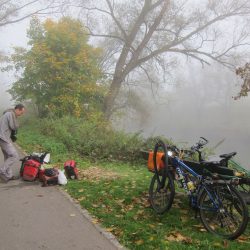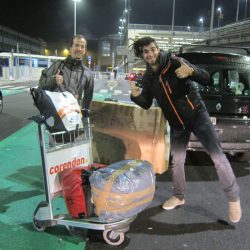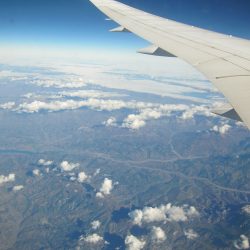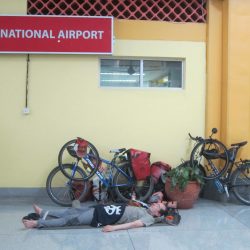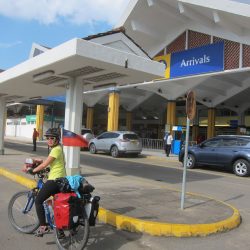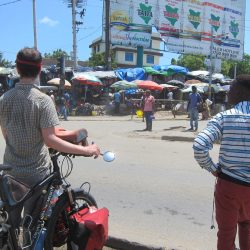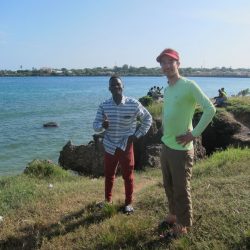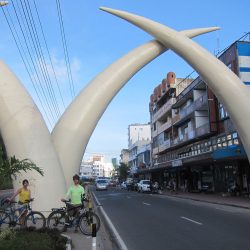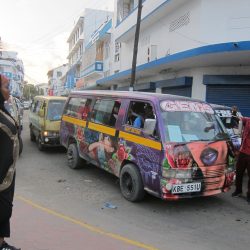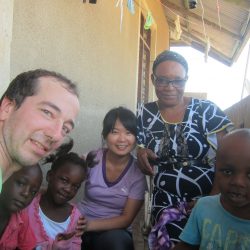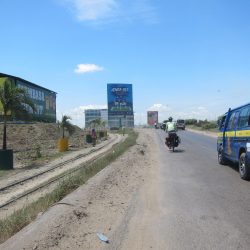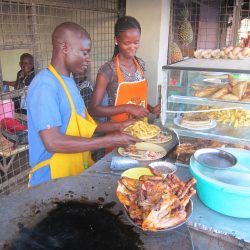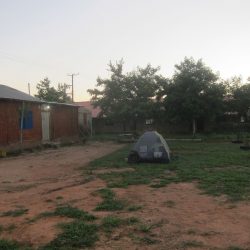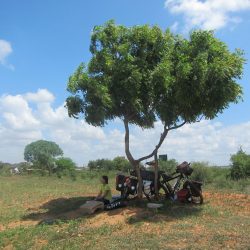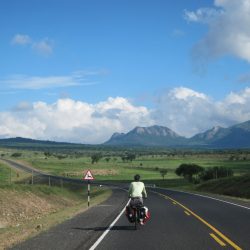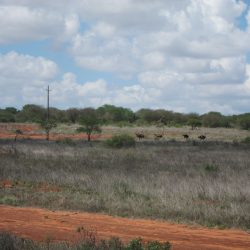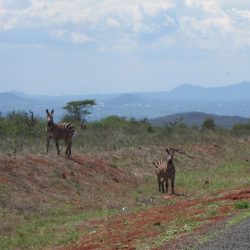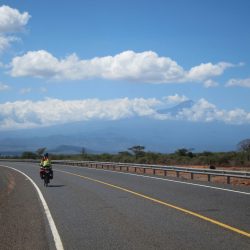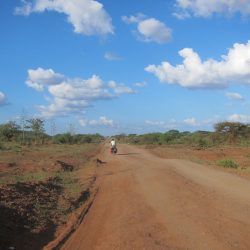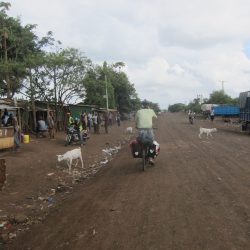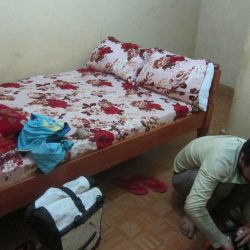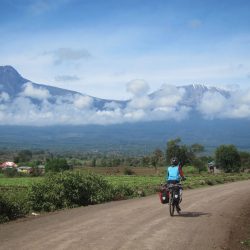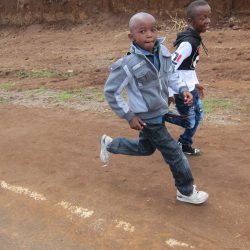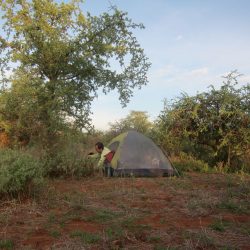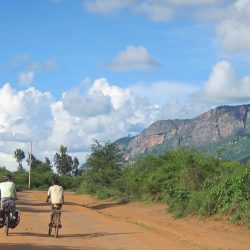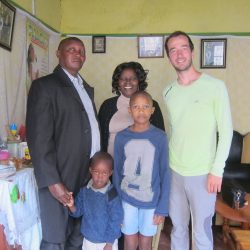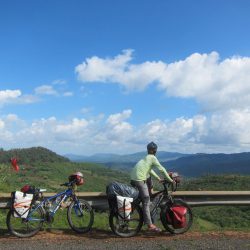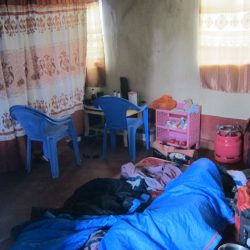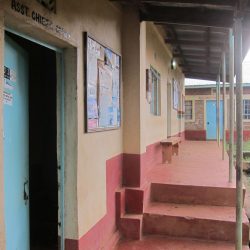The flights were booked, work was done, the decision was made: We were going to Africa. This continent still held lots of intimidation for me. Even though I read lots of blogs about people who cycled there, I still didn’t really know what to expect.
Preparations in Brussels
It was already the end of October when we made our way to Brussels. A week of chilly autumn cycling, that made me look forward to the heat of Kenya. We were still a month early, as we tried to source some visas. Yuily tried to get a South African visa, which unfortunately failed due to the strict residence requirements of the country and a 90 day maximum validity, too short for us to reach South Africa. This was an early blow to our plans. The only hope we have left of visiting South Africa now is a change of their visa policy. There are news reports out there that they are experimenting with an E-Visa system, so we hope for the best.
At the Kenyan embassy, we managed to get one East Africa Tourist visa each, in a much easier process. Valid for three countries, Kenya, Uganda and Rwanda, it helped to reduce the number of visa applications we have to make and the costs involved.
The whole time we managed to stay in Brussels thanks to the generosity of Gabriel, who we already met in Norway, and Elliot and Poling, an American-Taiwanese couple we found on warmshowers.org. It was fantastic to spend time with them and be at warm places during the increasingly cold days.
The time eventually came and we boarded our flight to Mombasa. We got a lift to the Airport thanks to Celine and Quentin, our last, generous hosts in Europe and arrived with extra time to spare. This was because I expected delays at the border check, since Yuily spent almost 8 months in the Schengen Area now. Since she is my wife, it would be standard procedure for her to have a residence card. But we haven’t been in a single EU country for long enough to apply for one, so all we had as a basis for her stay was the marriage certificate. While this is completely legal, I imagined it would still raise questions. I didn’t need to have worried. I just told the Belgian immigration officer “This is my wife” and he immediately stamped the passport and said “Have a nice trip” before I could even show the marriage certificate. Relief!
- Autumn cycling
- Poling and Elliot
- Brussels in all its glory
- Airport
Culture and other Shocks in Mombasa
It was a long, relatively eventless flight with a stopover in Zanzibar. The hot, humid air of Mombasa then hit us right as we left the airplane, as the terminal didn’t have air conditioning. Just like some other countries with close relations to China, the immigration officer didn’t stamp Yuilys passport but a separate paper. We later noticed that a duration of stay of one month was given on that paper, which was confusing, as the visa was valid longer than that. We hope it won’t lead to problems later.
Customs had some issues with our bicycles then. They claimed we would need to pay import tax on them and didn’t quite believe us when we said we wouldn’t sell them. To make sure, they made a handwritten note into my passport that the bikes have to leave the country with us. Weird, but at least we didn’t have to pay anything.
It was past 11 pm local time now and we proceeded to build the bikes and catch a few hours of sleep on the terminal floor, sweating buckets, trying to get used to the high humidity. Even though this was an airport, the culture shock was apparent. Positive though, as some people asked us questions about our trip and were friendly in general.
Upon riding into the town the next morning, it was the full blast of once more being in a developing country. Tuktuks, minibuses, overloaded trucks and motorbikes on the road with us, where traffic laws mean little and the right of way is quickly negotiated by eye contact and firm insistence. The smells and sights on the roadside were always changing, and the shouts from people welcoming us made it obvious that we were foreigners here, and everyone was able to immediately recognise us as such. And I loved it all.
- Flying
- Napping in Mombasa airport
- Ready to go
- Another world
We got through the city traffic to meet our host, Geoff. He told us we would stay in his Grandmother’s place, which was yet again a sudden throw into a different world. In the suburbs on a dirt road, in a share house she was living with a few foster children. There was no running water and no fans to relieve the heat, but she made more than up for it with her hospitality. I had to come to terms with it right away, this was not Europe anymore, this is Africa.
We enjoyed exploring the city the next few days while we ran a few errands. I got my yellow fever shot, necessary for traveling the next few countries, and while we were unable to source gas canisters, we found methylated spirit for our trusted beer can stove method. Unfortunately, I also entered a “losing things” spree. I had already forgotten Yuilys raincoat before the flight, our patch kit got lost as well as the chain breaker, and then worst of all my wallet slipped out of my pocket while cycling in the city. Some money, credit card, ID, drivers license, all gone. We had to rely on Yuilys credit card now until I get a replacement.
In other news though, Kenyan people were a delight. Many people were very friendly and polite to us, and while the attention we attracted was of course much higher than in Europe, especially from the children, it was never negative or too much, like in some other places we traveled to.
- Our host Geoff
- The Tusks
- Mombasa street scene
- Thank you!
Going Inland
The time eventually came to start cycling. Going inland from Mombasa, there is mostly just one highway, carrying all the traffic for the first 170 km. Luckily it had a decent shoulder, as there was a constant stream of trucks going past us. Heat breaks were a thing again, as the 12 to 4 period was simply too hot for us to cycle. But I definitely enjoyed one thing immediately compared to cycling in Europe: We could afford things again! The frequent availability of food at low prices meant that the days of supermarket lunches were over. An eating establishment, locally called “Hotel”, would often be a breakfast, lunch or dinner spot where we would order traditional Kenyan foods at rarely more than KSH100 (about €1) per person.
As we neared our first night on the road, a local Anglican bishop got attention of our story and invited us to camp near his church. The next night, the security guards of a radio tower invited us to spend the night. It was fantastic, spontaneous hospitality, like we experienced it in many places in Asia, was back.
- Main road
- Delicious local food
- Camping at a church
- Going to Voi
After the town of Voi, we got our first chance to turn off the busy highway and took it. This road took us towards Taveta on the border with Tanzania, and was nicer to cycle with less traffic. It also led right through the Tsavo National Park, giving us a chance to see some wildlife. The army guards had no problem letting us through, and we managed to spot giraffes, zebras and ostriches. It was all not without risk, as there are also lions and elephants in the park, which are not so much fun to encounter on a bicycle, so we kept moving quickly.
- Heat break
- Beware!
- Tsavo
- Ostrich and a Giraffe
- Zebras
- Kilimanjaro in sight
- Onto dirt
- Lake Chala
Negative effects of charity
In the national park also Kilimanjaro, Africa’s biggest mountain came into view. First covered in clouds, the top showed itself later in the day as we turned off on to a dirt road, following the contour of the base of the mountain. This is also where it got a lot tougher. Many of the children here were running towards us, screaming “Sweets”, and sometimes “Give me money / shoes / your bicycles”. This continued for the whole 60 km of dirt road. These demands were strongest around signs announcing aid projects by foreign governments. Obviously, some of these aid workers started handing out sweets and other things to these children, creating the expectation within them that all foreigners who come past will give them stuff. It is really terrible. The intention was good, to help relieve the poverty in the region, but I’m afraid it’s actually increasing poverty when children grow up receiving hand-outs, never learning to earn their own fortune, but waiting for foreigners to hand it to them.
I tried my best to give them my piece of mind, saying “Why should I give you sweets?” and “It’s very rude to treat a guest to your country like that”, but not sure if they understood enough English. Once, even a grown adult demanded the shoes on Yuilys bike and we had to scream at him for him to back off. After the town of Oloitokitok, we entered a more arid area, where some of the kids demanded water instead. We refused, indicating that we’re cycling and that they should ask a car. As I looked back, a car passed them and they didn’t even try. So they weren’t really thirsty, it was really just another case of expecting a hand-out from a foreigner.
The scenery in these parts was really beautiful though and changing frequently. The views of Mt. Kilimanjaro were often good, as we saw it from different angles. We also predicted one thing even before we came to Kenya, and that was that we would break a record. Since February 2017 we didn’t pay for accommodation on our cycling trips, always either managing to free camp or finding a host, due to the high cost of accommodation in Europe. But this cost was much lower again in Kenya, so the record was broken by first paying KSH300 for camping in a guesthouse, and a few days later KSH500 (4.5 €) for a simple room in one. That record was thus gone, but it was ok for us.
- Dirt roads
- A simple guesthouse
- Kilimanjaro!
- Begging kids…
Amazing Kenyan Hospitality
The arid area after that then had vegetation that was picture perfect Africa, and we managed to wild camp inside, dodging massive thorns. Just as quickly the scenery changed again as we crossed the main A109 highway in Emali and went on another dirt road into the mountains. These were beautiful mountains and unlike on our first dirt road, the people were really really friendly. The next few days we never camped: First, a catholic priest showed us to a room after our request to camp near his church, then, after a stop for drinks, we got talking to a buisnessman who lived nearby and told us to stay the night, then a couple working at a police station insisted us on spending two nights at their place. It was a great experience for Kenyan life and we learned so much in those encounters.
I try to put my experience a bit into words here, since, even though Kenya is a very touristy country, most tourists never actually interact with average Kenyans and their life, instead being ferried straight from the airport to their safari lodges. So, little is known to outsiders. Most Kenyans live in shared structures, sometimes made of wood or steel panels, but most often concrete. Electricity is almost everywhere, power outages are common but never last long. In a living room one might find sofas, tables and a cupboard with a TV, but often people live in small rooms without many possessions beside a mattress and a small shelf. Cooking is done either on a single stove stuck on top of a gas barrel or, more traditionally, a charcoal stove, using big aluminum pots. Ugali, a maize cake, is often the stock meal with sauces made from cabbage, beef, beans, tomatoes and other things. The quality of the vegetables is excellent and they are very tasty. Almost all dwellings don’t have running water, even though water taps are installed. Instead, water is filled from a rainwater tank, tanker truck or borehole into 20l jerry cans for daily tasks. It seemed to me that, while a running water system would be easy to install, most Kenyans simply prefer the jerry can method. Toilets are of the squat type, sometimes flushing with a bucket, sometimes drop type, but never smelly or excessively dirty. No matter how little people have, nearly everybody has a smartphone. 99% of people we interact with speak fluent English, although often with a strong accent.
- Wild camping
- Cycling with a local boy
- Hosted by a priest
- Beautiful but hard
- More spontaneous hosts
- Beautiful mountains
- A typical Kenyan home
- Outside
From here, we aimed to bypass Nairobi by crossing the central highlands. Pine forests and chilly temperatures waited for us.
Previous: Going North Part 3
